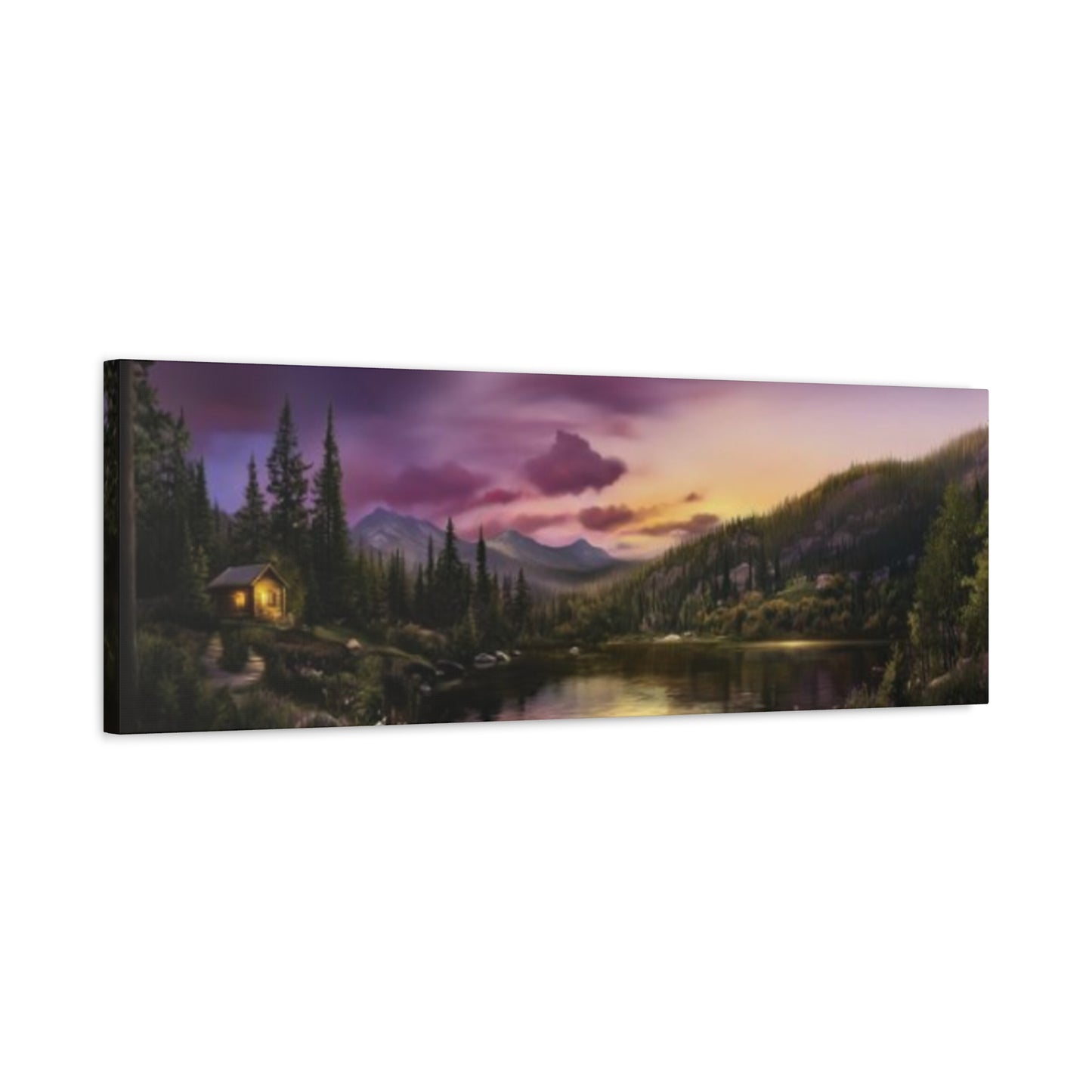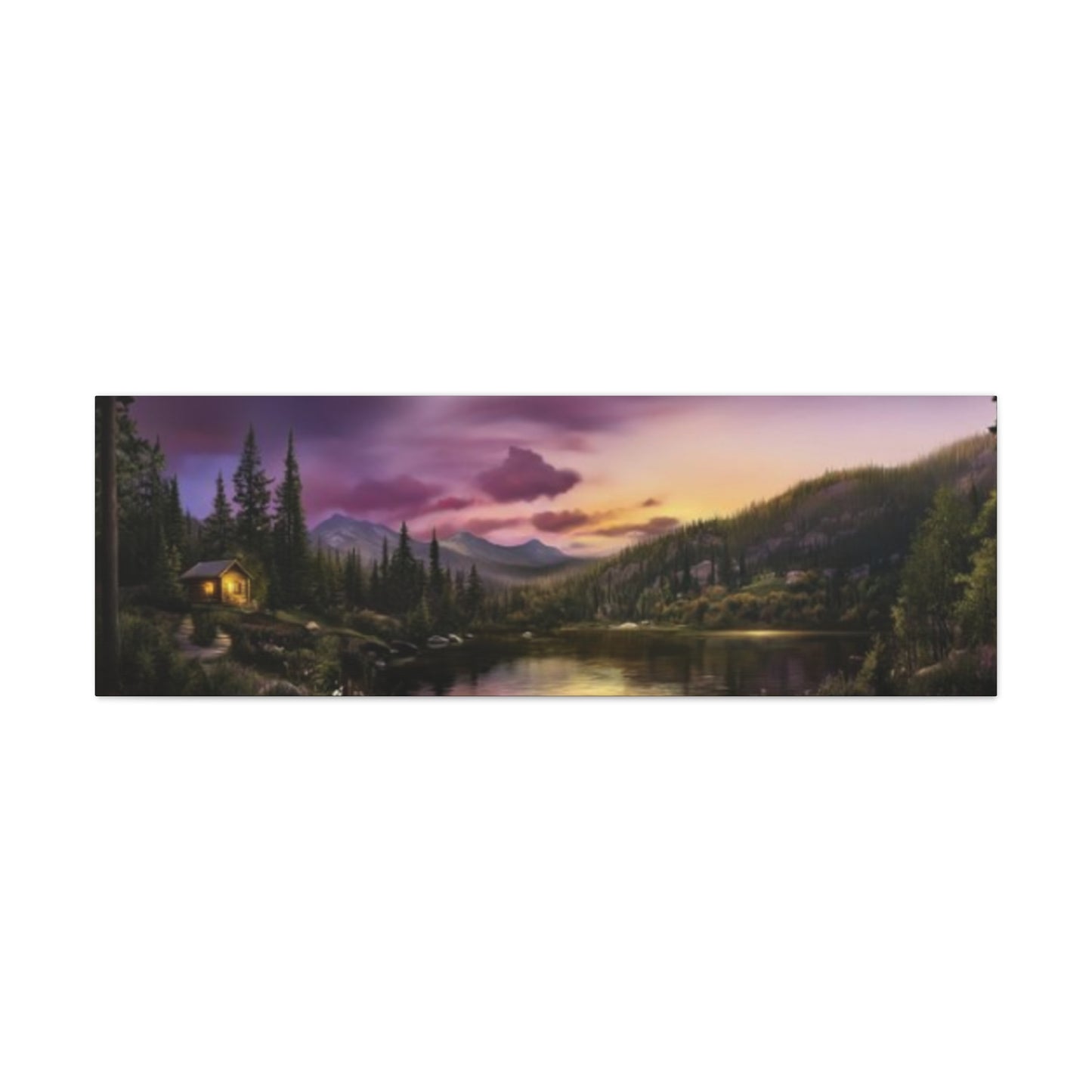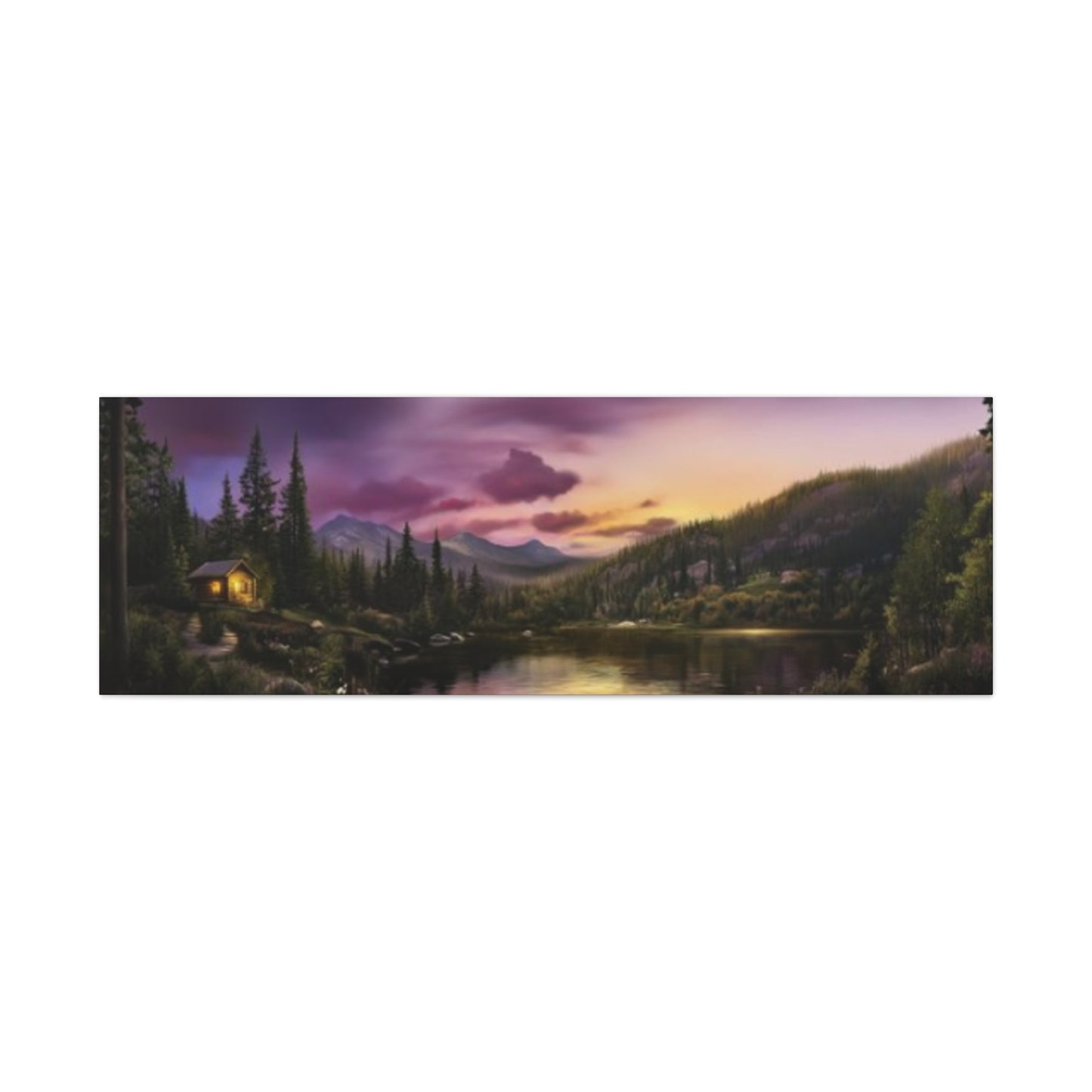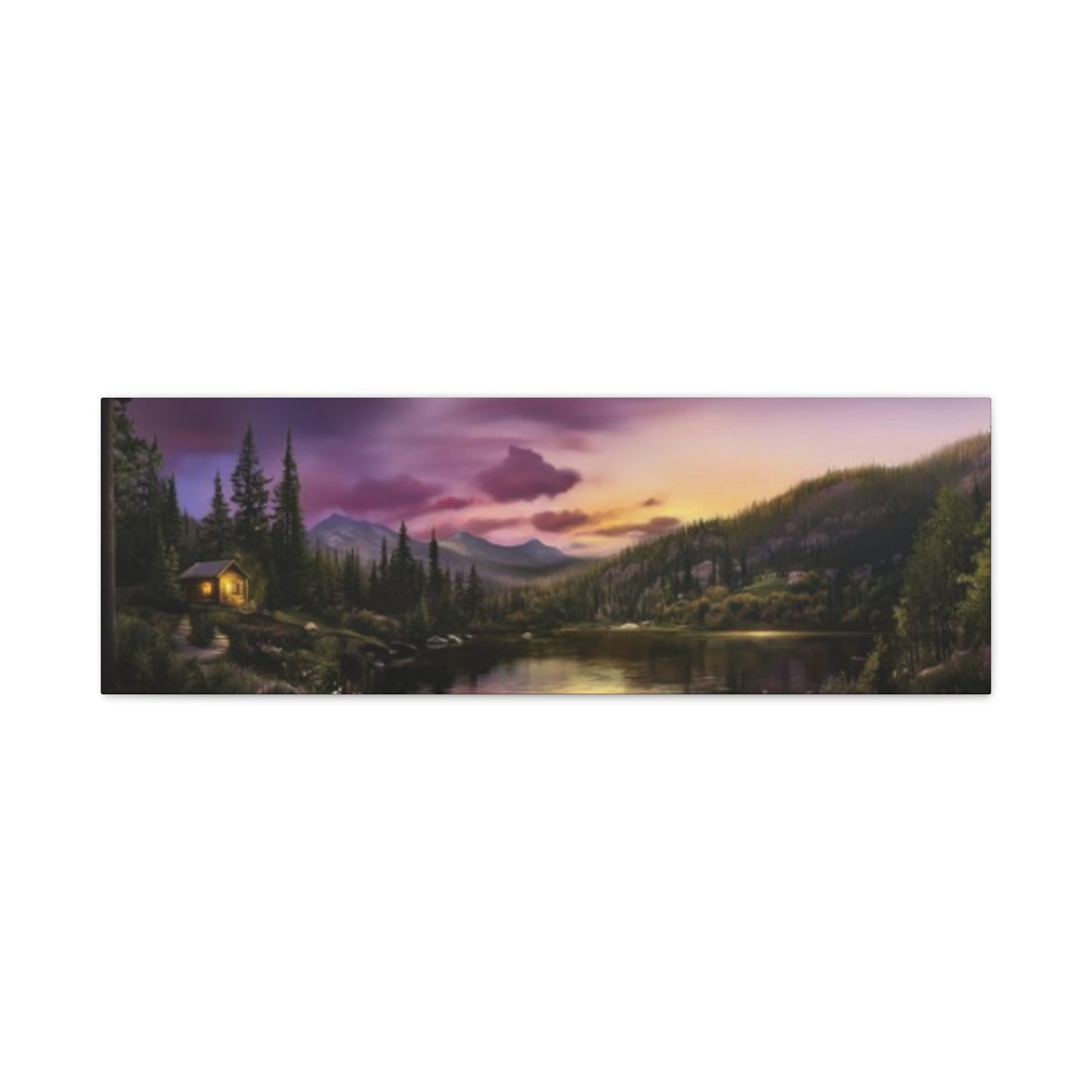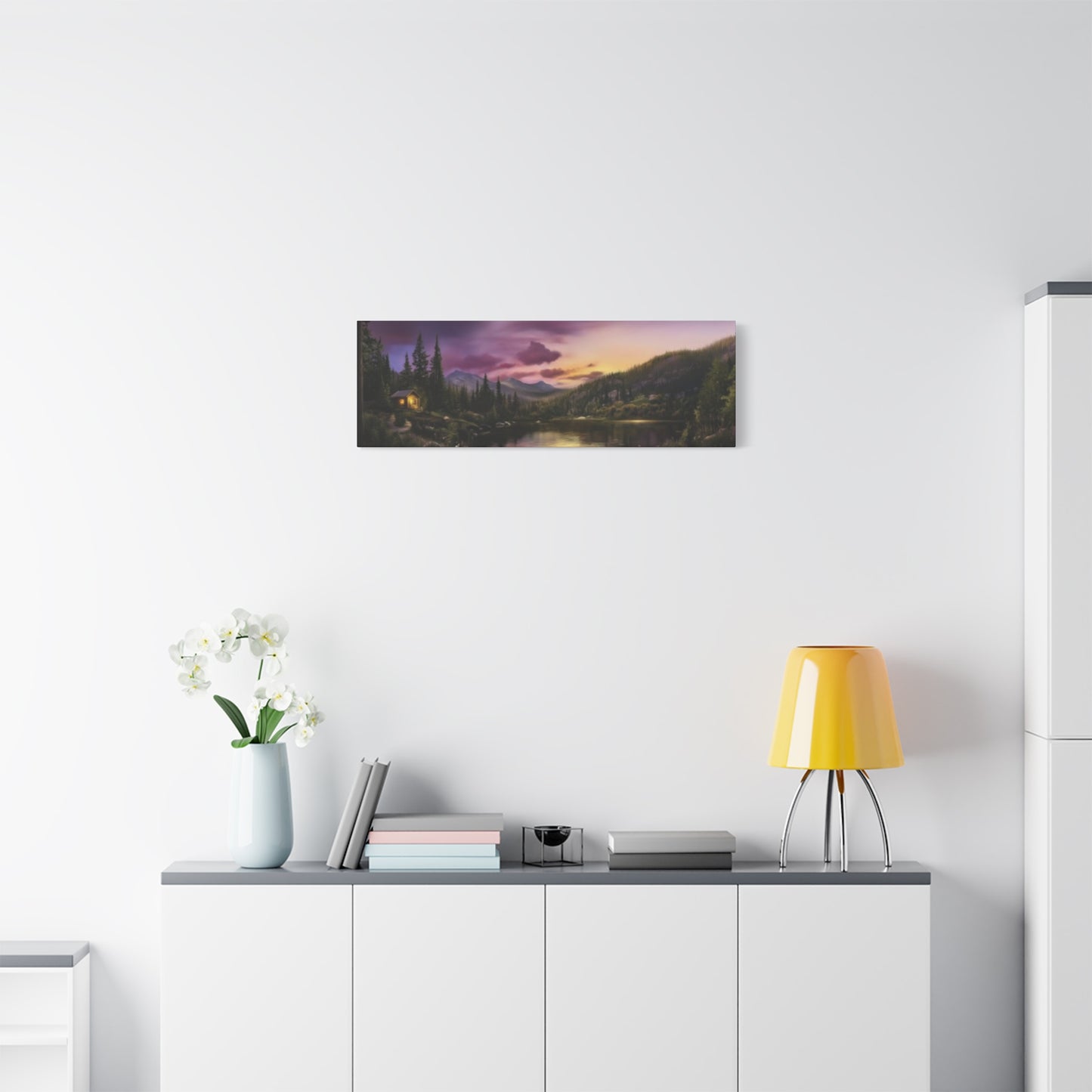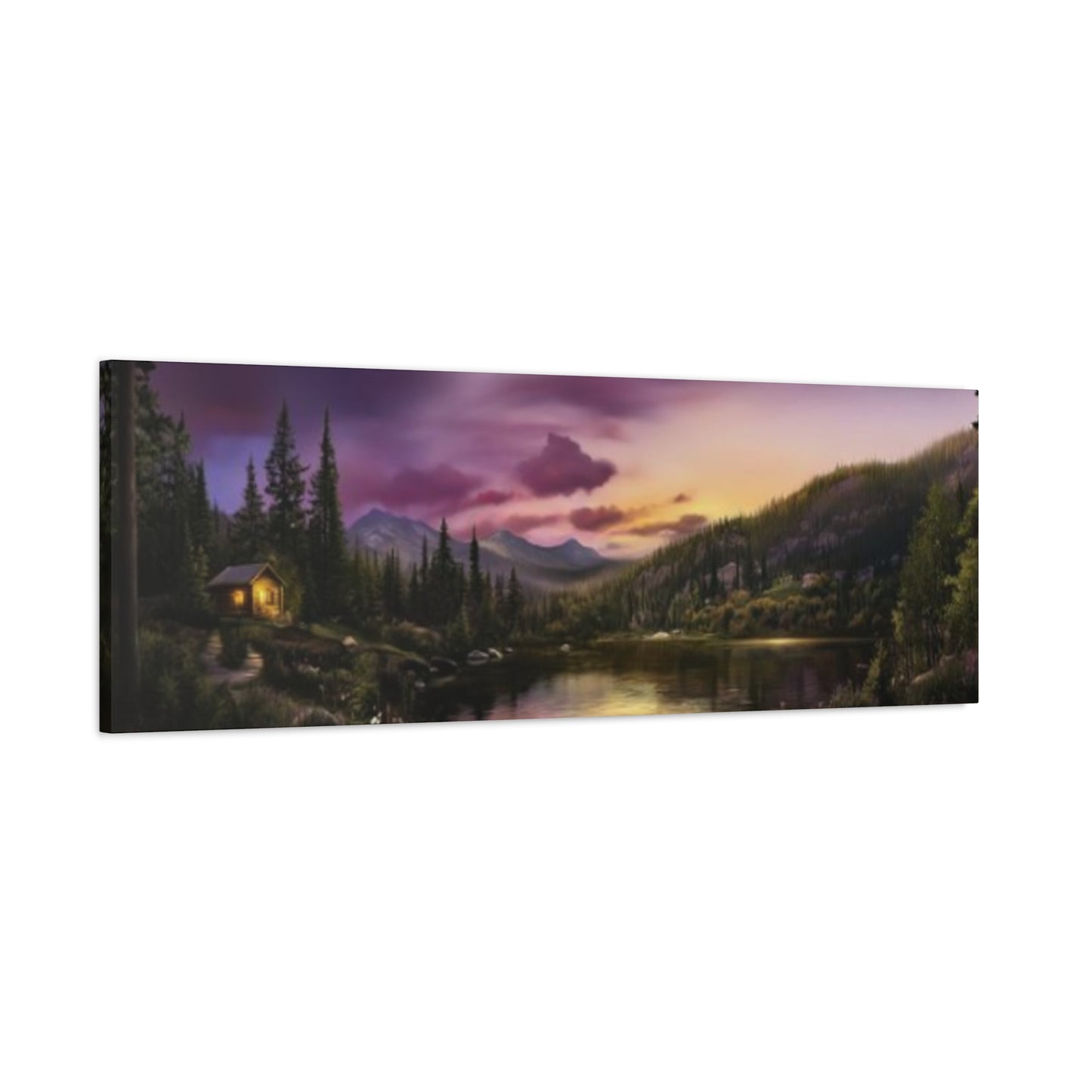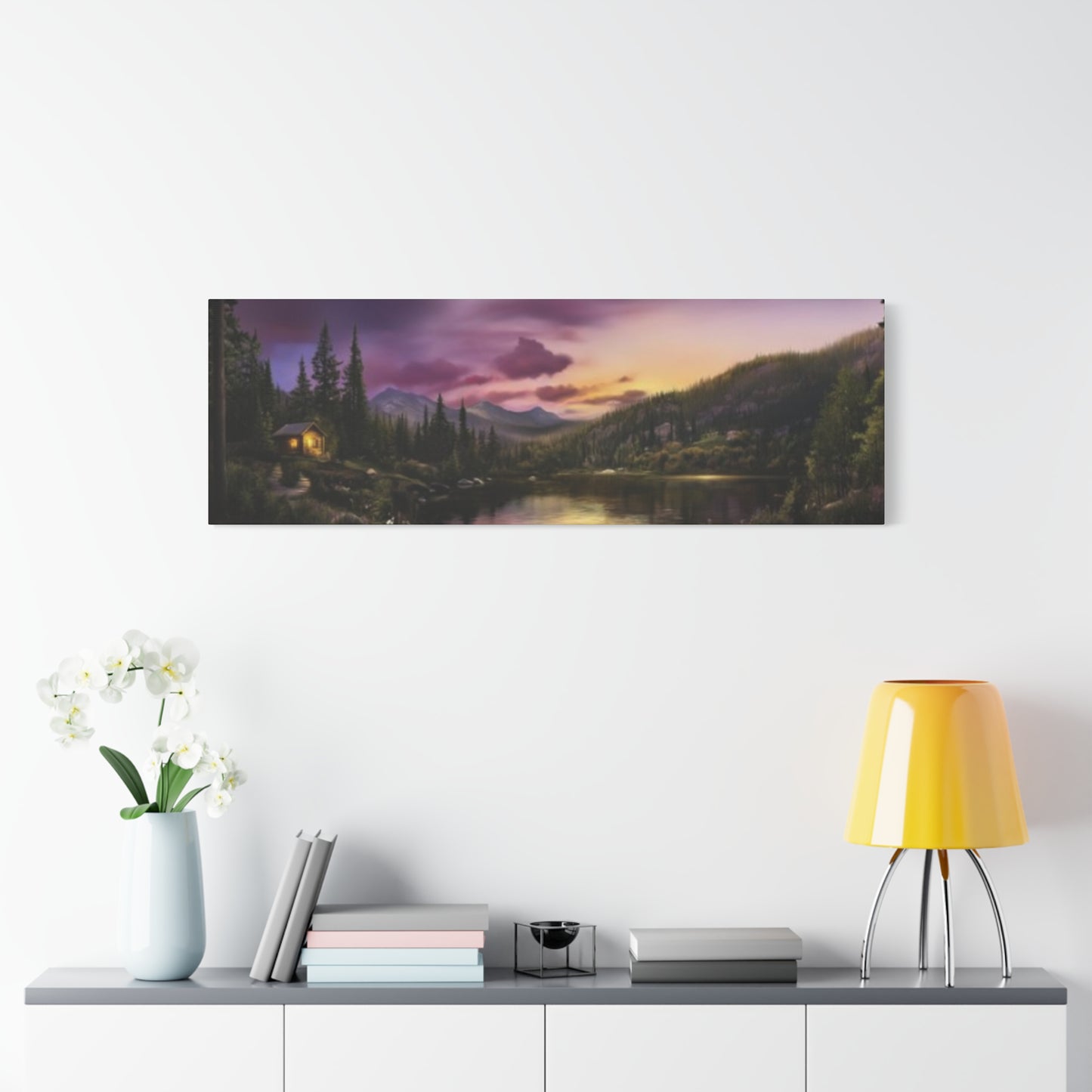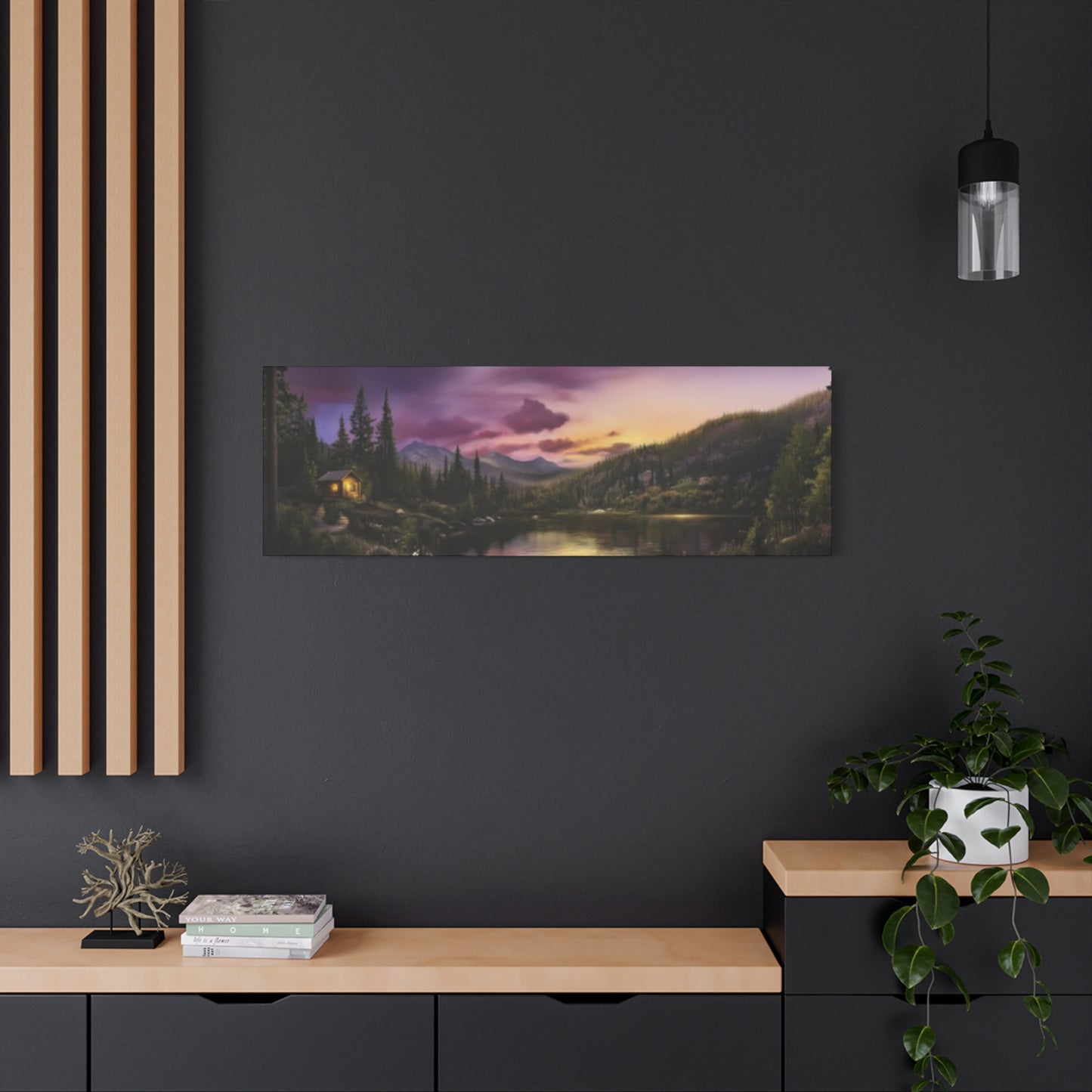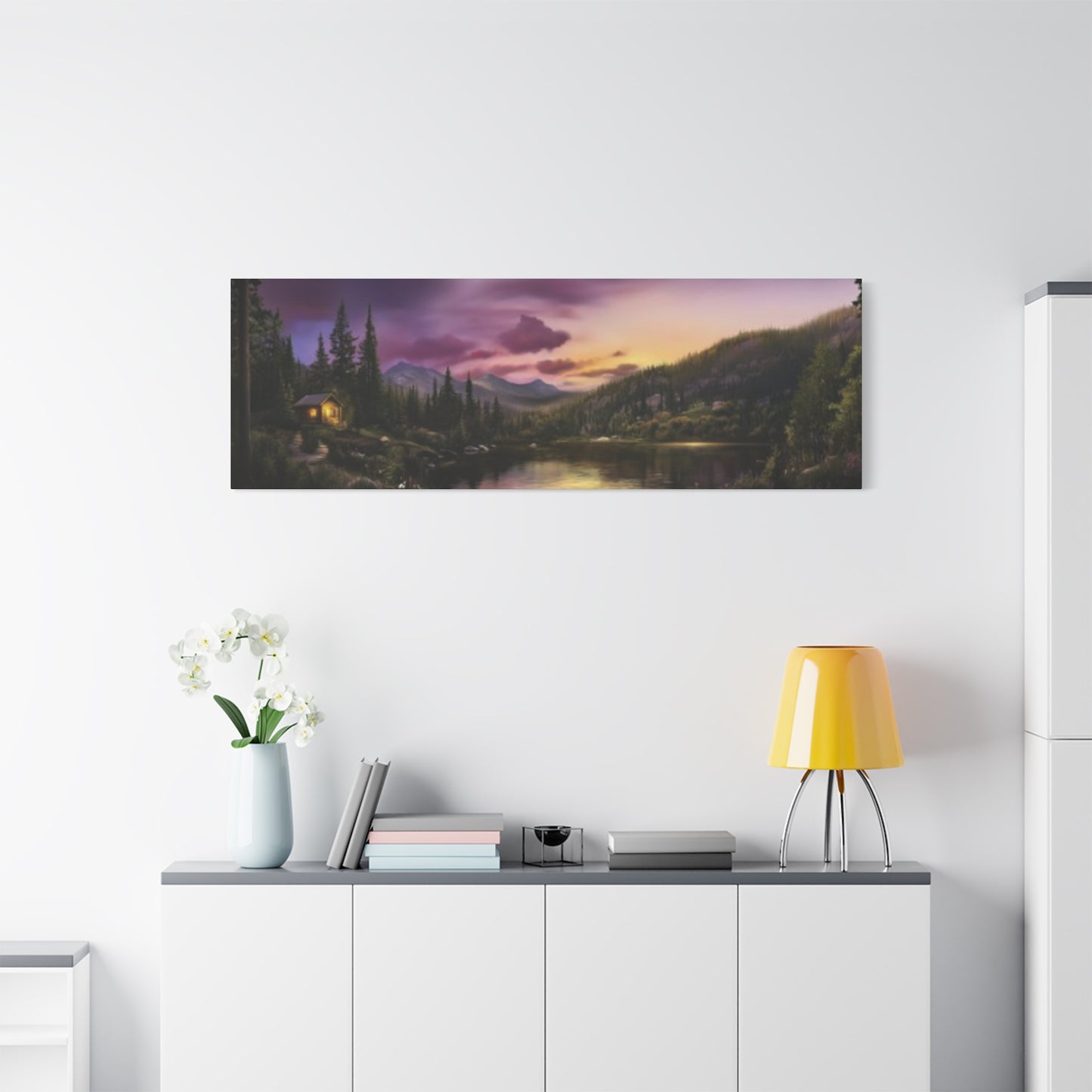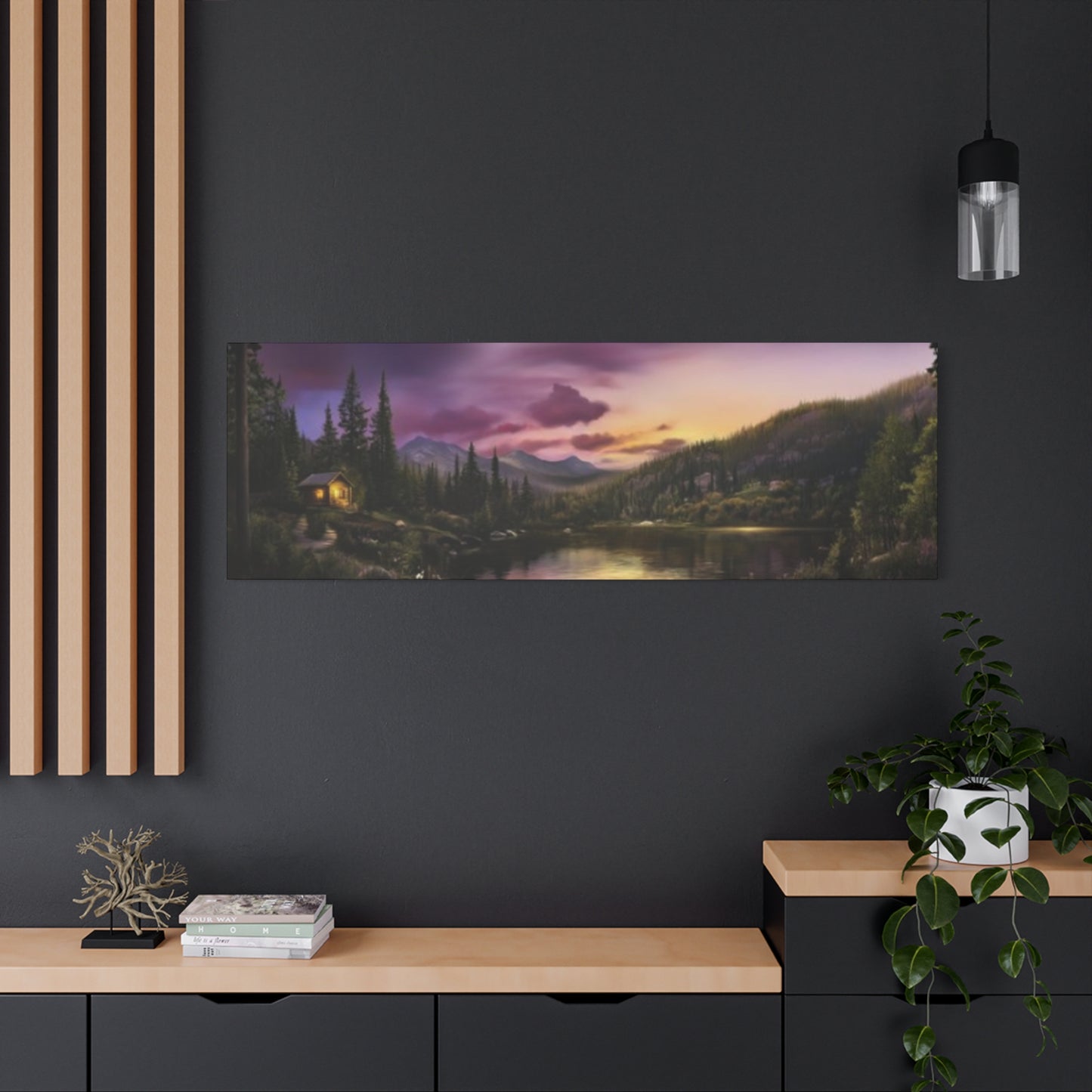Captivating Evening Wildlife Wall Art: Panoramic Nature Scenes
The enchanting beauty of wildlife during twilight hours has captivated humans for centuries. As daylight fades and evening shadows begin to dance across landscapes, nature reveals its most serene and mystical aspects. Evening wildlife wall art captures these magical moments, bringing the tranquil beauty of dusk-lit animals and panoramic nature scenes directly into our living environments. These artistic representations offer more than mere decoration; they provide windows into the peaceful world of wildlife as day transitions to night, creating atmospheric focal points that transform any room into a sanctuary of natural beauty.
Evening Wildlife Panoramas: Capturing Nature's Twilight Symphony
Evening wildlife panoramas represent some of the most breathtaking artistic expressions available in contemporary wall art collections. These expansive compositions showcase the dramatic interplay between fading daylight and emerging shadows, featuring wildlife in their natural habitats during the golden hours of dusk. The panoramic format allows artists to capture the full breadth of evening landscapes, from rolling hills dotted with grazing deer to wetlands where waterfowl gather for the night.
Professional wildlife photographers and digital artists spend countless hours waiting for the perfect evening light to capture these stunning moments. The resulting panoramas often feature silhouetted animals against brilliant sunset skies, creating powerful emotional connections between viewers and the natural world. These pieces work particularly well in larger rooms where their horizontal format can be fully appreciated, drawing the eye across the entire composition and creating the illusion of looking through a wide window into the wilderness.
The technical aspects of creating evening wildlife panoramas require exceptional skill and patience. Artists must balance the exposure between the bright evening sky and the darker foreground elements, ensuring that wildlife subjects remain visible while maintaining the dramatic lighting that makes these scenes so compelling. Advanced techniques such as focus stacking and exposure blending are often employed to create images with maximum detail and dynamic range.
Modern printing technologies have made it possible to reproduce these panoramas with stunning clarity and color accuracy on various materials, from traditional canvas to metal and acrylic substrates. Each material offers unique characteristics that can enhance different aspects of the artwork, with metallic prints particularly effective at capturing the luminous quality of evening light.
Wildlife at Dusk Wall Art: Embracing the Magic Hour
Wildlife at dusk wall art celebrates the enchanting period when day transitions to night, often referred to as the magic hour by photographers and artists. This golden time produces soft, warm lighting that bathes landscapes and wildlife in ethereal glows, creating some of the most emotionally resonant images in nature photography and art. The subdued lighting conditions during dusk reveal wildlife in their most relaxed states, as many animals become more active in the cooler temperatures and softer light.
Artists specializing in dusk wildlife art understand the importance of capturing not just the animals themselves, but the entire atmosphere of the evening environment. Mist rising from lakes, the last rays of sunlight filtering through forest canopies, and the gradual emergence of stars all contribute to the overall mood and impact of these artistic pieces. The resulting artwork often evokes feelings of peace, reflection, and connection with the natural world.
The color palettes typical in wildlife at dusk wall art tend toward warm earth tones, deep purples, and golden hues. These colors naturally complement most home decor styles, making dusk wildlife art particularly versatile for various design schemes. Whether displayed in living rooms, bedrooms, or office environments, these pieces bring a sense of calm and natural beauty that can help reduce stress and promote relaxation.
Contemporary wildlife artists often combine traditional photographic techniques with digital enhancement to create dusk wildlife art that captures the full emotional impact of these magical moments. This hybrid approach allows for greater creative control while maintaining the authentic beauty of natural wildlife encounters. The result is artwork that feels both realistic and dreamlike, perfectly capturing the mysterious quality of twilight hours.
Serene Evening Wildlife Prints: Tranquility in Artistic Form
Serene evening wildlife prints offer viewers an escape into the peaceful world of nature during its most tranquil hours. These artistic interpretations focus on the calm, meditative aspects of wildlife behavior during evening hours, when many animals settle into rest or engage in quiet feeding activities. The emphasis on serenity makes these prints particularly appealing for residential and commercial environments where creating a relaxing atmosphere is desired.
The selection of wildlife subjects for serene evening prints often includes animals known for their graceful, peaceful presence: swans gliding across still waters, deer grazing in meadows, or owls perched silently on branches. These subjects are typically portrayed in moments of quiet contemplation or gentle movement, avoiding the dramatic action shots that characterize other forms of wildlife art. Instead, the focus remains on creating a sense of harmony between the animals and their evening environments.
Print quality plays a crucial role in conveying the serene atmosphere these pieces are meant to evoke. High-resolution printing techniques ensure that subtle details such as the soft texture of animal fur, the gentle ripples on water surfaces, and the delicate gradations of evening light are accurately reproduced. Many collectors prefer giclée printing methods for serene wildlife art, as this technique provides exceptional color fidelity and longevity.
The framing and presentation of serene evening wildlife prints can significantly impact their effectiveness in creating peaceful environments. Simple, elegant frames that complement rather than compete with the artwork help maintain the tranquil mood. Additionally, proper lighting considerations ensure that the subtle beauty of evening wildlife scenes is appreciated without harsh shadows or glare that might detract from the serene atmosphere.
Panoramic Wildlife at Sunset: Capturing Golden Moments
Panoramic wildlife at sunset represents the pinnacle of evening nature art, combining the dramatic beauty of sunset lighting with the majesty of wild animals in their natural habitats. These expansive compositions showcase the full spectacle of nature during one of the day's most visually stunning periods, when the sun's low angle creates long shadows, warm light, and brilliant colors that transform ordinary landscapes into extraordinary artistic subjects.
The technical challenges of creating panoramic sunset wildlife art are considerable. Artists must work quickly during the brief window when sunset lighting is optimal, often requiring extensive preparation and local knowledge to position themselves where wildlife is likely to appear. The use of telephoto lenses and specialized equipment allows photographers to capture intimate wildlife moments while maintaining the expansive feel of panoramic compositions.
Successful panoramic sunset wildlife art balances multiple elements: the dramatic sky, the landscape features, and the wildlife subjects must all work together harmoniously. Composition techniques such as the rule of thirds, leading lines, and strategic placement of wildlife within the frame help create visually compelling pieces that draw viewers into the scene. The horizontal format of panoramic art makes it particularly suitable for spaces with long wall segments, where the full impact of the sunset landscape can be appreciated.
Digital processing techniques have revolutionized the creation of panoramic sunset wildlife art. Advanced software allows artists to blend multiple exposures, extend depth of field, and enhance color saturation while maintaining natural-looking results. These tools enable the creation of artwork that captures not just the visual appearance of sunset wildlife encounters, but also the emotional impact of experiencing these moments in person.
Calm Wildlife Evening Scenes: Nature's Peaceful Moments
Calm wildlife evening scenes focus on the peaceful, undisturbed moments when animals exist in harmony with their twilight environments. These artistic representations emphasize the gentle side of wildlife behavior, showcasing animals during their quiet activities such as drinking from streams, resting in grassy clearings, or engaging in peaceful social interactions. The emphasis on calmness makes these pieces particularly effective for creating relaxing environments in homes, offices, and healthcare facilities.
Artists creating calm evening wildlife scenes often employ soft focus techniques and muted color palettes to enhance the peaceful mood of their compositions. Rather than sharp, dramatic contrasts, these pieces feature gentle transitions between light and shadow, creating artwork that feels contemplative and soothing. The choice of wildlife subjects typically includes animals that naturally convey a sense of peace and gentleness: rabbits in meadows, birds at rest, or grazing ungulates in pastoral settings.
The psychological impact of calm wildlife evening scenes has been studied extensively, with research indicating that exposure to peaceful nature imagery can reduce stress levels, lower blood pressure, and improve overall mental well-being. This makes calm wildlife art not just aesthetically pleasing but potentially beneficial for health and wellness. Many healthcare facilities, meditation centers, and therapeutic environments specifically choose calm wildlife evening scenes for their positive psychological effects.
Contemporary printing and display technologies allow calm wildlife evening scenes to be presented in ways that maximize their peaceful impact. Large-format printing capabilities enable the creation of immersive pieces that surround viewers with tranquil natural beauty. Additionally, advances in LED lighting systems allow for optimal illumination that enhances the gentle qualities of these artworks without creating harsh contrasts that might disrupt their calming effects.
Dusk Wildlife Panorama Prints: Expansive Evening Beauty
Dusk wildlife panorama prints offer viewers the opportunity to experience the full breadth of evening wildlife habitats through expansive horizontal compositions. These prints capture the essence of wildlife-rich environments during the magical transition period between day and night, when soft lighting conditions create optimal opportunities for observing and photographing animal behavior. The panoramic format allows artists to include environmental context that helps viewers understand the relationship between wildlife and their habitats.
The creation of dusk wildlife panorama prints often involves sophisticated camera techniques and post-processing workflows. Panoramic photography may require multiple overlapping images that are later stitched together using specialized software. This process allows for extremely high-resolution final images that maintain sharp detail across the entire width of the composition. Wildlife photographers working in panoramic formats must possess exceptional technical skills and intimate knowledge of animal behavior to successfully capture these complex compositions.
The horizontal orientation of panorama prints makes them ideal for specific architectural environments. Long hallways, above sectional furniture, or in rooms with horizontal design elements can all be enhanced by the addition of dusk wildlife panorama prints. The expansive nature of these pieces can make rooms appear larger and more open, while the wildlife subjects add life and interest to otherwise plain wall surfaces.
Quality considerations for dusk wildlife panorama prints include careful attention to color accuracy across the entire width of the image, consistent sharpness from edge to edge, and appropriate substrate selection that complements the artistic content. Many collectors prefer canvas or fine art paper prints for panoramic wildlife art, as these materials provide excellent color reproduction and can be stretched or mounted to create seamless presentations without visible joints or borders.
Wildlife Twilight Wall Decor: Mystical Evening Ambiance
Wildlife twilight wall decor encompasses artistic pieces that capture the mysterious, almost magical quality of wildlife during the twilight hours. This period, occurring twice daily during the transition between day and night, creates unique lighting conditions that transform familiar landscapes into ethereal environments where wildlife takes on an otherworldly appearance. Artists specializing in twilight wildlife decor understand how to harness these special atmospheric conditions to create compelling wall art.
The color characteristics of twilight lighting provide artists with a distinctive palette that includes deep purples, soft blues, and warm golden tones. These colors create natural harmony in residential decor while providing enough visual interest to serve as striking focal points. Wildlife subjects photographed or painted during twilight often appear as dramatic silhouettes or semi-silhouettes, creating strong graphic elements that work well in contemporary decor schemes.
Modern wildlife twilight wall decor often incorporates mixed media approaches, combining photography with digital artistry to enhance the mystical qualities of twilight wildlife encounters. Artists may selectively enhance certain elements of their compositions while maintaining photographic realism in others, creating pieces that feel both authentic and fantastical. This approach allows for greater creative expression while preserving the essential character of the wildlife subjects.
The psychological impact of wildlife twilight wall decor relates to the human fascination with mystery and the unknown. Twilight has historically been associated with magic, transformation, and the boundary between the known and unknown worlds. Wildlife art that captures these twilight moments can evoke feelings of wonder, contemplation, and connection with forces larger than ourselves. These emotional responses make twilight wildlife decor particularly effective in environments where inspiration and reflection are valued.
Peaceful Evening Animal Art: Harmony in Nature
Peaceful evening animal art focuses specifically on the serene behavioral aspects of wildlife during the calm hours of early evening. As temperatures begin to cool and harsh midday sun gives way to gentler lighting, many animals exhibit their most relaxed and peaceful behaviors. Artists capturing these moments create artwork that emphasizes harmony, balance, and the natural rhythms that govern wildlife activity patterns throughout the day.
The subject selection for peaceful evening animal art typically includes species and behaviors that naturally convey tranquility. Grazing animals in open meadows, waterfowl floating on still ponds, and small mammals engaged in gentle foraging activities all provide ideal subjects for this genre. The key is capturing animals when they are unhurried and unstressed, displaying the natural peace that characterizes their lives when human interference is minimal.
Artistic techniques used in creating peaceful evening animal art often emphasize soft edges, gentle color transitions, and balanced compositions that avoid jarring contrasts or dramatic elements that might disturb the peaceful mood. Photographers may use diffusion filters or soft lighting techniques to create dreamy, ethereal effects that enhance the tranquil atmosphere. Painters and digital artists often employ blending techniques that create seamless transitions between subjects and backgrounds.
The commercial appeal of peaceful evening animal art extends beyond traditional wildlife enthusiasts to include anyone seeking to create calming environments in their homes or workplaces. The stress-reducing qualities of peaceful nature imagery have made this type of art particularly popular in therapeutic settings, meditation rooms, and wellness centers. The universal appeal of peaceful animals transcends cultural boundaries, making these pieces suitable for diverse audiences and environments.
Sunset Wildlife Panorama Canvas: Dramatic Evening Displays
Sunset wildlife panorama canvas pieces represent some of the most visually striking options available in evening wildlife wall art collections. The combination of dramatic sunset lighting with expansive panoramic compositions creates artwork that commands attention while providing immersive viewing experiences. Canvas substrates are particularly well-suited to sunset wildlife panoramas because they can accommodate the wide format requirements while providing rich color reproduction that captures the full impact of sunset lighting.
The technical aspects of creating sunset wildlife panorama canvas pieces involve careful consideration of the dramatic lighting conditions that occur during sunset hours. Photographers must balance the brilliant colors and intense contrast of sunset skies with the need to maintain detail and natural coloration in wildlife subjects. Advanced camera techniques such as graduated neutral density filters and exposure bracketing are often employed to capture the full dynamic range of sunset scenes.
Canvas printing technology has advanced significantly in recent years, allowing for extremely wide panoramic prints that maintain consistent quality across their entire width. Modern large-format canvas printers can produce seamless prints several feet wide, creating impressive wall installations that transform ordinary rooms into gallery-like environments. The texture of canvas adds depth and dimension to sunset wildlife panoramas, enhancing their visual impact and creating artwork that rewards close examination.
The installation and display considerations for sunset wildlife panorama canvas pieces require attention to both technical and aesthetic factors. Proper stretching and mounting techniques ensure that large canvas pieces remain flat and wrinkle-free over time. Lighting systems should be designed to evenly illuminate the entire width of panoramic pieces while avoiding glare and reflections that might detract from the dramatic sunset colors that make these pieces so compelling.
Evening Nature Panorama Prints: Comprehensive Twilight Landscapes
Evening nature panorama prints expand beyond individual wildlife subjects to encompass entire ecosystems during the transitional hours of dusk and early evening. These comprehensive compositions showcase the interconnected relationships between wildlife, plant life, and environmental features that define natural habitats during their most photogenic hours. The panoramic format allows viewers to experience the full scope and complexity of natural environments as they exist during evening hours.
Creating evening nature panorama prints requires extensive field work and intimate knowledge of local ecosystems. Artists must understand the timing of various natural phenomena, from the emergence of nocturnal animals to the behavior patterns of evening-active birds and the way different plant species respond to changing light conditions. This comprehensive approach results in artwork that educates viewers about natural processes while providing aesthetic pleasure.
The technical challenges of creating evening nature panorama prints include managing the complex lighting conditions that occur during evening hours, when different parts of the landscape may be illuminated by varying intensities and colors of light. Advanced photography techniques such as focus stacking and luminosity masking allow artists to create images that maintain sharp detail throughout the composition while preserving the natural lighting characteristics that define evening landscapes.
Contemporary display technologies enable evening nature panorama prints to be presented in ways that maximize their educational and aesthetic impact. Large-format printing capabilities allow for highly detailed reproductions that reveal the intricate relationships between different elements within natural ecosystems. Interactive display systems can even provide additional information about the species and habitats shown in panoramic prints, creating educational opportunities alongside aesthetic experiences.
Wildlife Silhouettes at Dusk: Dramatic Shadow Play
Wildlife silhouettes at dusk represent one of the most graphically striking approaches to evening wildlife art. By reducing animal subjects to their essential shapes against dramatically lit skies, artists create powerful compositions that emphasize form, behavior, and the relationship between wildlife and their environments. The silhouette technique transforms familiar animals into iconic shapes that convey maximum impact with minimal detail.
The creation of effective wildlife silhouettes at dusk requires careful timing and positioning to capture animals when they are backlit by evening skies. Photographers must anticipate animal behavior and position themselves where silhouetted subjects will be most effectively framed against colorful or textured backgrounds. The technical approach involves underexposing subjects while maintaining proper exposure for background elements, creating the dramatic contrast that defines silhouette photography.
Artistic considerations for wildlife silhouettes at dusk include the selection of animals and poses that create recognizable and aesthetically pleasing shapes. Birds in flight, deer with raised heads, and predators in stalking positions all provide excellent silhouette subjects because their characteristic poses are easily identifiable even when reduced to simple outlines. The composition must also consider how multiple silhouettes interact within the frame to create balanced, harmonious arrangements.
The versatility of wildlife silhouettes at dusk makes them suitable for a wide range of design applications. The simplified graphic nature of silhouette art allows it to complement both traditional and contemporary decor styles, while the dramatic nature of the imagery provides visual interest without overwhelming other design elements. Additionally, the emotional impact of silhouetted wildlife against evening skies creates artwork that resonates with viewers on both aesthetic and emotional levels.
Soft Light Wildlife Wall Art: Gentle Evening Illumination
Soft light wildlife wall art celebrates the gentle, diffused lighting conditions that occur during evening hours when the harsh directional light of midday gives way to the warm, even illumination that photographers and artists prize for its flattering qualities. This type of lighting reveals wildlife subjects in their most appealing states, with soft shadows that define form without creating harsh contrasts, and even illumination that brings out the natural colors and textures of animal subjects.
The technical achievement of soft light wildlife art requires understanding of natural lighting patterns and often involves working during specific times of day when atmospheric conditions create optimal lighting. Evening hours frequently provide these conditions naturally, as the sun's low angle creates longer light paths through the atmosphere, resulting in diffusion and warming effects that enhance the appearance of wildlife subjects.
Artists working with soft light conditions often employ techniques that preserve and enhance these natural lighting characteristics. Careful exposure control ensures that highlights don't become overblown while shadows retain sufficient detail to reveal important features of animal subjects. Post-processing techniques may be used to selectively enhance the soft lighting effects while maintaining the natural appearance that makes these images so appealing.
The aesthetic appeal of soft light wildlife wall art extends to its psychological effects on viewers. Soft, even lighting creates feelings of comfort and relaxation, making these pieces particularly suitable for residential environments and spaces where stress reduction is important. The gentle nature of soft lighting also complements the peaceful behaviors often exhibited by wildlife during evening hours, creating harmonious compositions that feel naturally balanced and serene.
Golden Hour Wildlife Panoramas: Nature's Perfect Light
Golden hour wildlife panoramas capture the magical period shortly before sunset when natural lighting reaches its most photographically perfect state. During this brief window, typically lasting 20-30 minutes, the sun's low angle creates warm, golden light that transforms landscapes and wildlife subjects into glowing, ethereal scenes. The panoramic format allows artists to capture the full scope of golden hour lighting effects across wide landscape vistas populated with wildlife.
The timing requirements for successful golden hour wildlife panoramas demand exceptional planning and preparation. Artists must thoroughly understand local weather patterns, seasonal animal behavior, and the specific timing of golden hour conditions throughout the year. Location scouting becomes critical, as photographers need to identify spots where wildlife is likely to appear during the brief golden hour window while also providing suitable vantage points for panoramic compositions.
Technical execution of golden hour wildlife panoramas requires mastery of exposure techniques that preserve the luminous quality of golden hour lighting while maintaining detail in both highlight and shadow areas. The extreme contrast between bright sky and darker foreground elements challenges conventional exposure approaches, often requiring specialized techniques such as graduated neutral density filters or exposure blending in post-processing.
The emotional impact of golden hour wildlife panoramas stems from the universal human response to golden lighting conditions. These warm, glowing scenes evoke feelings of peace, contentment, and connection with natural beauty that transcend cultural differences. The combination of perfect natural lighting with majestic wildlife subjects creates artwork that consistently generates positive emotional responses from viewers across diverse backgrounds and preferences.
Evening Calm Wildlife Prints: Serenity in Nature
Evening calm wildlife prints focus on capturing and conveying the profound sense of peace that pervades natural environments during the quiet hours of early evening. As the activities and urgency of midday give way to the restful preparation for night, wildlife exhibits behaviors and occupies environments that naturally convey tranquility and harmony. Artists specializing in evening calm wildlife prints understand how to recognize and capture these serene moments.
The behavioral aspects of wildlife during calm evening periods provide rich subject matter for artistic interpretation. Animals at rest, engaged in gentle social interactions, or participating in peaceful feeding activities all contribute to the overall sense of calm that defines this genre. The key is selecting moments when wildlife appears most relaxed and undisturbed, creating images that invite viewers to share in the peaceful atmosphere of natural environments.
Artistic techniques used to enhance the calm qualities of evening wildlife prints often involve subtle manipulation of contrast, color saturation, and edge sharpness. Rather than dramatic contrasts and bold colors, calm wildlife art typically employs gentle tonal variations and muted palettes that support the peaceful mood. Edge softening techniques may be used selectively to create dreamlike qualities that enhance the serene atmosphere.
The practical applications of evening calm wildlife prints extend beyond simple decoration to include therapeutic and wellness-related uses. Healthcare facilities, counseling centers, and meditation environments often incorporate calm wildlife art as part of healing-supportive design strategies. The stress-reducing qualities of peaceful nature imagery have been documented in numerous studies, making calm wildlife prints valuable tools for creating environments that support mental and emotional well-being.
Nature's Evening Panorama Art: Comprehensive Twilight Vistas
Nature's evening panorama art takes a holistic approach to capturing the complete natural environment during the transformative hours of dusk and early evening. Rather than focusing solely on individual wildlife subjects, this genre encompasses entire ecosystems in their evening states, showing how all elements of natural environments interact during twilight hours. The panoramic format provides the breadth necessary to showcase these comprehensive natural scenes.
The ecological knowledge required to create authentic nature's evening panorama art extends beyond simple photography skills to include understanding of habitat relationships, seasonal patterns, and the complex interactions between different species and their environments. Artists must recognize how changing light conditions affect not just the appearance of landscapes but also the behavior patterns of various wildlife species that inhabit them.
Composition considerations for nature's evening panorama art involve balancing multiple elements within wide horizontal frames. Wildlife subjects must be positioned to create focal points without overwhelming the broader landscape context, while environmental features such as water bodies, vegetation, and topographical elements contribute to the overall story being told through the artwork. The challenge lies in creating unified compositions that feel natural and unforced.
The educational value of nature's evening panorama art makes it particularly suitable for institutional settings such as nature centers, schools, and museums. These comprehensive views of natural environments during evening hours can illustrate ecological concepts while providing aesthetic experiences. Interactive display technologies can enhance educational applications by providing additional information about the species, habitats, and processes shown in panoramic artwork.
Wildlife Sunset Canvas Prints: Vibrant Evening Colors
Wildlife sunset canvas prints showcase the most dramatically colorful period of the evening hours, when the sun's low angle creates brilliant displays of warm colors that transform both skies and landscapes into vibrant artistic subjects. Canvas substrates are particularly well-suited to sunset wildlife art because they can accurately reproduce the rich, saturated colors that characterize these dramatic lighting conditions while providing the texture and depth that enhance the visual impact of sunset scenes.
The color science involved in creating accurate wildlife sunset canvas prints requires understanding of how different printing technologies and substrates reproduce the complex color relationships present in sunset lighting. The warm reds, oranges, and yellows that dominate sunset skies must be balanced with the cooler tones often present in shadow areas and reflected light, creating challenging color management requirements for both artists and print technicians.
Artistic composition in wildlife sunset canvas prints must account for the dramatic lighting conditions that can easily overwhelm wildlife subjects if not handled skillfully. Silhouette techniques are often employed to maintain the visibility of animal subjects against brilliant sunset backgrounds, while careful positioning ensures that wildlife elements enhance rather than compete with the spectacular color displays that define sunset scenes.
The emotional impact of wildlife sunset canvas prints derives from the powerful human response to sunset colors combined with the majesty of wild animals in their natural habitats. These pieces often evoke feelings of wonder, inspiration, and connection with natural beauty that makes them particularly effective as focal points in residential and commercial environments. The vibrant colors of sunset wildlife art can energize and uplift viewers while maintaining the peaceful qualities associated with evening wildlife scenes.
Twilight Wildlife Wall Decor: Mysterious Evening Beauty
Twilight wildlife wall decor captures the enigmatic period when day transitions to night, creating atmospheric conditions that lend themselves to mysterious and evocative artistic interpretations. The unique lighting characteristics of twilight, with its deep blue skies and subtle illumination, provide artists with opportunities to create wildlife art that feels both realistic and fantastical. This mysterious quality makes twilight wildlife decor particularly appealing for creating dramatic and sophisticated decor schemes.
The technical challenges of creating twilight wildlife wall decor involve working in extremely low light conditions while maintaining sufficient detail in wildlife subjects to create compelling artistic compositions. Advanced camera equipment and techniques are often required to capture sharp, detailed images during the brief twilight period when lighting conditions are optimal for this type of photography.
Color management in twilight wildlife art requires careful attention to the subtle gradations of blue and purple that characterize twilight skies, as well as the neutral tones that predominate in low-light wildlife subjects. The limited color palette of twilight scenes can actually work to the artist's advantage, creating harmonious compositions that rely on subtle tonal variations rather than bold color contrasts for their visual impact.
The psychological associations of twilight with mystery, transition, and the boundary between known and unknown realms give twilight wildlife wall decor particular power to create atmospheric environments. These pieces work especially well in spaces where creating a sense of drama, contemplation, or sophistication is desired. The mysterious quality of twilight wildlife art can transform ordinary rooms into more intriguing and emotionally engaging environments.
Evening Wildlife Scene Art: Narrative Natural Moments
Evening wildlife scene art focuses on capturing complete environmental contexts that tell stories about wildlife behavior and habitat relationships during the peaceful hours of early evening. Rather than isolated animal portraits, these pieces showcase wildlife subjects within their natural environments, revealing how animals interact with their habitats during the transition from day to night. The narrative aspect of scene art makes it particularly engaging for viewers who appreciate learning about natural processes through artistic representation.
The storytelling elements present in evening wildlife scene art require artists to possess extensive knowledge of animal behavior, habitat requirements, and ecological relationships. Successful scene art captures authentic moments that reveal something meaningful about wildlife lives and natural processes. This might include predator-prey interactions, family group behaviors, feeding activities, or social interactions that occur naturally during evening hours.
Composition techniques used in evening wildlife scene art must balance multiple elements to create coherent narratives while maintaining aesthetic appeal. Foreground, middle ground, and background elements all contribute to the story being told, while lighting and color choices support the overall mood and atmosphere of the scene. The challenge lies in creating compositions that feel natural and unposed while still providing clear focal points and visual flow.
The educational potential of evening wildlife scene art makes it valuable for nature education programs, wildlife conservation organizations, and environmental awareness campaigns. By showing wildlife in realistic habitat contexts, scene art can help viewers understand the complex relationships that exist in natural environments while building appreciation for wildlife conservation needs. The narrative quality of scene art also makes it more memorable and impactful than simple animal portraits.
Panorama of Wildlife at Dusk: Wide-Angle Evening Views
Panorama of wildlife at dusk represents the culmination of wide-angle wildlife photography, capturing expansive views of natural environments populated with wildlife during the magical transition period between day and night. These ultra-wide compositions provide viewers with immersive experiences that simulate the feeling of standing in wildlife habitats during some of nature's most beautiful hours. The extreme width of panoramic formats allows artists to include environmental context that helps viewers understand the scale and complexity of wildlife habitats.
Creating panorama of wildlife at dusk requires sophisticated equipment and techniques that go beyond conventional wildlife photography approaches. Ultra-wide angle lenses, panoramic camera systems, or digital stitching techniques may be employed to achieve the extreme horizontal aspect ratios that define this genre. The technical challenges include maintaining consistent exposure and color balance across very wide compositions while ensuring that wildlife subjects remain clearly visible within the broader landscape context.
The compositional considerations for panorama of wildlife at dusk involve distributing visual elements across extremely wide horizontal formats without creating empty or uninteresting areas. Wildlife subjects must be positioned to create multiple points of interest while maintaining overall compositional balance. Environmental features such as water bodies, vegetation patterns, and topographical elements help guide the viewer's eye across the wide composition.
The impact of panorama of wildlife at dusk on viewers relates to the immersive quality of ultra-wide compositions that can make viewers feel as though they are actually present in natural environments. This sense of presence can be particularly powerful when combined with the emotional appeal of dusk lighting and peaceful wildlife behaviors. Large-scale installations of panoramic wildlife art can transform spaces by creating windows into natural worlds that extend far beyond the physical boundaries of interior environments.
Quiet Evening Wildlife Prints: Undisturbed Natural Moments
Quiet evening wildlife prints celebrate the most peaceful and undisturbed moments in the daily lives of wild animals during the serene hours of early evening. These artistic pieces focus on capturing wildlife when they are most relaxed and natural, free from human interference or environmental stress. The emphasis on quietude makes these prints particularly effective for creating calming environments that promote relaxation and stress relief.
The behavioral aspects captured in quiet evening wildlife prints typically include animals at rest, engaged in gentle grooming activities, peacefully foraging, or participating in calm social interactions. The key is recognizing and capturing moments when wildlife exhibits their most natural, unstressed behaviors. These authentic moments create artwork that feels genuine and emotionally resonant with viewers who appreciate the peaceful aspects of natural life.
Artistic techniques used to enhance the quiet qualities of evening wildlife prints often involve subtle approaches to lighting, composition, and post-processing. Rather than dramatic contrasts or bold artistic statements, quiet wildlife art relies on gentle tonal variations, soft lighting effects, and harmonious color relationships that support the peaceful mood. The goal is creating artwork that whispers rather than shouts, inviting contemplation rather than demanding attention.
The therapeutic applications of quiet evening wildlife prints have made them popular choices for healthcare facilities, meditation centers, and wellness-focused environments. Research has consistently shown that exposure to peaceful nature imagery can have measurable positive effects on stress levels, blood pressure, and overall mental well-being. The quiet quality of these prints makes them particularly effective for environments where healing and relaxation are primary goals.
The market appeal of quiet evening wildlife prints extends beyond traditional wildlife art collectors to include anyone seeking to create peaceful, stress-reducing environments in their homes or workplaces. The universal human need for tranquility and connection with nature makes quiet wildlife art relevant across diverse demographic groups and cultural backgrounds. These pieces work particularly well in bedrooms, reading areas, and other environments where quiet contemplation is valued.
Creating authentic quiet evening wildlife prints requires patience, field skills, and intimate knowledge of wildlife behavior patterns. Artists must spend considerable time in natural environments, learning to recognize the subtle signs that indicate when animals are truly relaxed and undisturbed. This observational skill, combined with technical photographic expertise, enables the creation of artwork that captures the genuine quietude that characterizes wildlife during their most peaceful moments.
The printing and presentation considerations for quiet evening wildlife prints should support and enhance their peaceful qualities. High-quality printing techniques that preserve subtle tonal variations and gentle color transitions are essential for maintaining the quiet atmosphere these pieces are meant to convey. Framing choices should complement rather than compete with the artwork, while lighting systems should provide even, non-glaring illumination that allows viewers to appreciate the subtle beauty of quiet wildlife moments.
Modern display technologies offer new opportunities for presenting quiet evening wildlife prints in ways that maximize their calming effects. Digital display systems can adjust brightness and color temperature throughout the day to maintain optimal viewing conditions, while interactive features can provide additional information about the wildlife species and behaviors shown in the artwork. These technological enhancements can deepen viewer engagement while preserving the essential quiet quality that defines this genre.
Conclusion
Evening wildlife wall art represents one of the most emotionally compelling and aesthetically rewarding genres available in contemporary nature art collections. From expansive panoramic views that capture entire ecosystems during twilight hours to intimate portraits of individual animals in peaceful evening moments, this diverse category offers something to appeal to every taste and decorating need. The universal human fascination with wildlife combined with the magical quality of evening light creates artistic combinations that consistently generate positive emotional responses from viewers across cultural and demographic boundaries.
The technical evolution of wildlife photography and digital art has opened unprecedented opportunities for artists to capture and present evening wildlife scenes with stunning clarity and emotional impact. Advanced camera equipment, sophisticated printing technologies, and innovative display methods have made it possible to bring the full beauty and tranquility of evening wildlife encounters into residential and commercial environments. These technological advances ensure that contemporary evening wildlife wall art can faithfully reproduce the subtle lighting conditions, rich colors, and intricate details that make evening wildlife encounters so memorable.
The psychological and therapeutic benefits associated with evening wildlife wall art extend far beyond simple aesthetic appreciation. Research consistently demonstrates that exposure to peaceful nature imagery can reduce stress, lower blood pressure, improve mental well-being, and create more positive emotional states. The combination of wildlife subjects with the inherently calming qualities of evening lighting creates artwork that not only beautifies environments but also contributes to the health and wellness of those who experience it regularly.
The versatility of evening wildlife wall art makes it suitable for an enormous range of applications, from intimate residential settings to large commercial installations. The wide variety of formats available, including traditional prints, canvas reproductions, metal substrates, and digital displays, ensures that evening wildlife art can be successfully integrated into virtually any design scheme or architectural environment. Whether used as dramatic focal points or as subtle background elements, evening wildlife art brings natural beauty and peaceful energy to human environments.
The educational value inherent in evening wildlife wall art should not be overlooked in considering its broader cultural significance. By showcasing wildlife in authentic habitat contexts during natural behavioral periods, this art form helps viewers develop deeper appreciation for natural processes and wildlife conservation needs. The visual accessibility of wall art makes it an effective medium for environmental education that reaches audiences who might not otherwise engage with conservation messages through traditional channels.
As human populations become increasingly urbanized and disconnected from natural environments, evening wildlife wall art serves an important role in maintaining connections between people and the natural world. These artistic representations provide windows into wildlife experiences that many people rarely have opportunities to witness firsthand. By bringing the peace and beauty of evening wildlife encounters into daily living environments, this art form helps preserve and strengthen the human-nature bond that is essential for long-term environmental stewardship.













